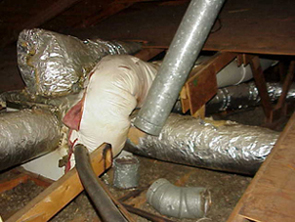A friend of mine from the Waco, Texas, area, Steve Wiggins, recently sent me a story about a situation he encountered involving possible CO poisoning. This story, however, has a happy ending, thanks to one alert HVAC professional.

Steve’s Story
“The home was a rental unit in central Texas occupied by a nice older couple,” Wiggins reported. “I visited the home in late August. I found a grounded compressor in an old outdoor unit. The split system’s indoor equipment was approximately five years old. The indoor coil and gas furnace were mounted upflow in a hallway closet.“I stuck my head up in the 150 degree F attic and saw older rigid ductwork. I assumed it had some leaks, but this attic was so unfriendly I decided to let the old ducts stay. The plenum was almost inaccessible due to the truss rafters and the ductwork filling the space between the trusses. Also, the plenum was down the full length of the house and around the corner, so I couldn’t see it from the attic scuttle hole.
“I decided not go in the dangerously hot attic at that time.
“I quoted a price to replace the outdoor unit and the owner was contacted. I then quoted a compressor only replacement and informed them of the disadvantages of replacing just the compressor.
“After no return call, I assumed they found someone else to do the job cheaper. A month went by and I got a call from the owner authorizing me to replace the outdoor unit. Since they had waited this long with Texas temperatures in the upper 90s, I knew money must be tight for them. At the time, I decided the existing indoor coil was acceptable to leave in place, given the financial circumstances and since there was no evidence of burnout.
“These poor folks suffered a month in the heat with no air in a brick home with very little attic ventilation. There were two whirlybird vents on the roof and only a few soffit vents. It was a gable roof with no vents in the gable ends at all.
“I ended up changing my mind about leaving the old indoor coil. I decided to eat the extra cost and labor to install a new indoor coil at no extra charge to them. I don’t usually give coil replacements away for free, but something was telling me to do just that in this case.
“It was a good thing I did, because that is how I discovered that the flue pipe was disconnected in the attic. During replacement of the coil, I had to remove the flue. I pushed it up and it went up very easy — way too easy, in fact. I inched my way through the tight attic one joist at a time to see why the vent pipe was loose.
“I saw where the flue had been apart for quite some time, as evidenced by the brown burn marks on the white duct insulation. In addition, I saw a terrible duct board plenum with the top unsecured on two edges and one 9-inch duct take-off dangling by its metal ears. Some gaps were so large I could stick my fingers through. I also noticed the two whirlybird vents had been sealed off from underneath with styrofoam.
“The CO was venting directly in the attic, and the supply duct leaks were forcing the noxious gas right in the home; it really had no place else to go, other than what could escape through the few dirt-clogged soffit vents.
“This is a just another great reason to own a CO detector with digital readout. Who knows, this might have been the last winter these poor unsuspecting folks ever enjoyed.
“If I could offer any advice to other technicians, it would be to please be professional enough to take the time to check the little extras that may go unnoticed. It was only a grounded compressor in the beginning, but with a little extra digging it turned out to be a lifesaving service call.”
Good advice Steve — very good advice.
John Hall is business management editor. He can be reached at 248-244-1294, 248-362-0317 (fax), or johnhall@achrnews.com.
Publication date: 10/06/2003
Report Abusive Comment